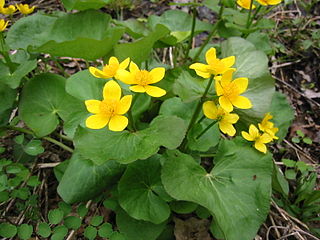
Xanthium (cocklebur) is a genus of flowering plants in the tribe Heliantheae within the family Asteraceae, native to the Americas and eastern Asia and some parts of south Asia.

Matricaria is a genus of flowering plants in the chamomile tribe within the sunflower family. Some of the species have the common name of "mayweed", but this name also refers to plants not in this genus.

Caltha palustris, known as marsh-marigold and kingcup, is a small to medium sized perennial herbaceous plant of the buttercup family, native to marshes, fens, ditches and wet woodland in temperate regions of the Northern Hemisphere. It flowers between April and August, dependent on altitude and latitude, but occasional flowers may occur at other times.

Cyperus is a large genus of about 700 species of sedges, distributed throughout all continents in both tropical and temperate regions.

Caltha is a genus of rhizomatous perennial flowering plants in the family Ranunculaceae, to which ten species have been assigned. They occur in moist environments in temperate and cold regions of both the Northern and Southern Hemispheres. Their leaves are generally heart-shaped or kidney-shaped, or are characteristically diplophyllous. Flowers are star shaped and mostly yellow to white. True petals and nectaries are missing but the five or more sepals are distinctly colored. As usual in the buttercup family there is a circle of stamens around free carpels.

Sparganium (bur-reed) is a genus of flowering plants, described as a genus by Linnaeus in 1753. It is widespread in wet areas in temperate regions of both the Northern and Southern Hemispheres. The plants are perennial marsh plants that can grow to 3.5 m, with epicene flowers.

Eriophorum is a genus of flowering plants in the family Cyperaceae, the sedge family. They are found throughout the arctic, subarctic, and temperate portions of the Northern Hemisphere in acid bog habitats, being particularly abundant in Arctic tundra regions.

Marsilea is a genus of approximately 65 species of aquatic ferns of the family Marsileaceae. The name honours Italian naturalist Luigi Ferdinando Marsili (1656–1730).

Rhodiola is a genus of perennial plants in the family Crassulaceae that resemble Sedum and other members of the family. Like sedums, Rhodiola species are often called stonecrops. Some authors merge Rhodiola into Sedum.

Achillea nobilis, the noble yarrow, is a flowering plant in the sunflower family. It is native to Eurasia, widespread across most of Europe and also present in Turkey, the Caucasus, and Central Asia. It is reportedly present in Xinjiang Province in western China, but this is based on a single herbarium specimen collected in the 19th century. The species is widely cultivated and has become naturalized outside of its range in North America and other parts of the world.

Equisetum palustre, the marsh horsetail, is a plant species belonging to the division of horsetails (Equisetopsida). It is widespread in cooler regions of North America and Eurasia.

Iva is a genus of wind-pollinated plants in the family Asteraceae, described as a genus by Linnaeus in 1753. Plants of this genus are known generally as marsh elders. The genus is native to North America.

Caltha leptosepala, the white marsh marigold, twinflowered marsh marigold, or broadleaved marsh marigold, is a North American species of flowering plant in the buttercup family. The species has regionally distinct variations.

Bidens cernua is a species of flowering plant in the aster family, Asteraceae. Bidens cernua is distributed throughout much of Eurasia and North America. It is commonly called nodding beggarticks or nodding bur-marigold.

Micropus, the cottonseeds, is a genus of flowering plants in the tribe Gnaphalieae within the family Asteraceae.

Chrysogonum is a genus of flowering plants in the family Asteraceae found in eastern North America. Confusion regarding species that were named in Chrysogonum from other parts of the world, such as Madagascar, was clarified by Stuessy who reduced the genus to having only a single species with two varieties. A similar treatment was proposed by Nesom, although in that treatment 3 varieties were accepted. The plants are low-growing terrestrial herbs with yellow flower heads containing both disc florets and ray florets. The genus is distinctive in having pistillate ray florets and staminate disk florets, and the pistil of the ray floret is fused to the adjacent phyllary as well as 3 paleae and their associated disk florets to form a "cypsela complex". The species is grown as an ornamental plant under the common name of Green and Gold, and is used primarily as a ground cover.

Potamogeton polygonifolius or bog pondweed is an aquatic plant. It is found in shallow, nutrient-poor, usually acid standing or running water, bogs, fens and occasionally ditches.

Achillea alpina, commonly known as alpine yarrow, Chinese yarrow or Siberian yarrow, is an Asian and North American species of plant in the sunflower family. It is native to Siberia, the Russian Far East, China, Mongolia, Korea, Japan, Nepal, Canada, the northern United States.
Caltha scaposa is a low, perennial herb with one or two yellow hermaphrodite saucer-shaped flowers. This marsh-marigold species belongs to the buttercup family, grows in moist alpine fields and is native to the eastern Himalayas and the mountains on the eastern margin of the Tibetan highland.

Stellaria alsine, the bog stitchwort, is a species of herbaceous perennial flowering plant in the carnation family Caryophyllaceae. It grows in bogs and marshes in Europe and parts of North America.



















